Tramadol: Risks, Benefits, Addiction, and Global Policy Implications
VerifiedAdded on 2022/09/02
|6
|2823
|25
Report
AI Summary
This report provides a comprehensive analysis of Tramadol, an opioid analgesic, examining its risks and benefits within the United States and globally. It explores the drug's classification, prevalence of use, and its increasing popularity, particularly in regions like Southeast Asia. The report delves into the benefits of Tramadol in pain management, comparing its potency and side effects to other opioids. It also highlights the adverse effects, including addiction, respiratory depression, and cardiovascular dysregulation, and discusses the drug's interaction with CYP2D6. Furthermore, the report investigates the varying patterns of Tramadol addiction across different countries, such as the US, Iran, and China, and analyzes the reasons behind these differences, including policy variations and prescription practices. The report concludes with a discussion on the need for physician education, policy changes, and a collective approach to minimize Tramadol addiction worldwide, emphasizing the importance of considering alternative analgesics and promoting public awareness of the drug's risks.
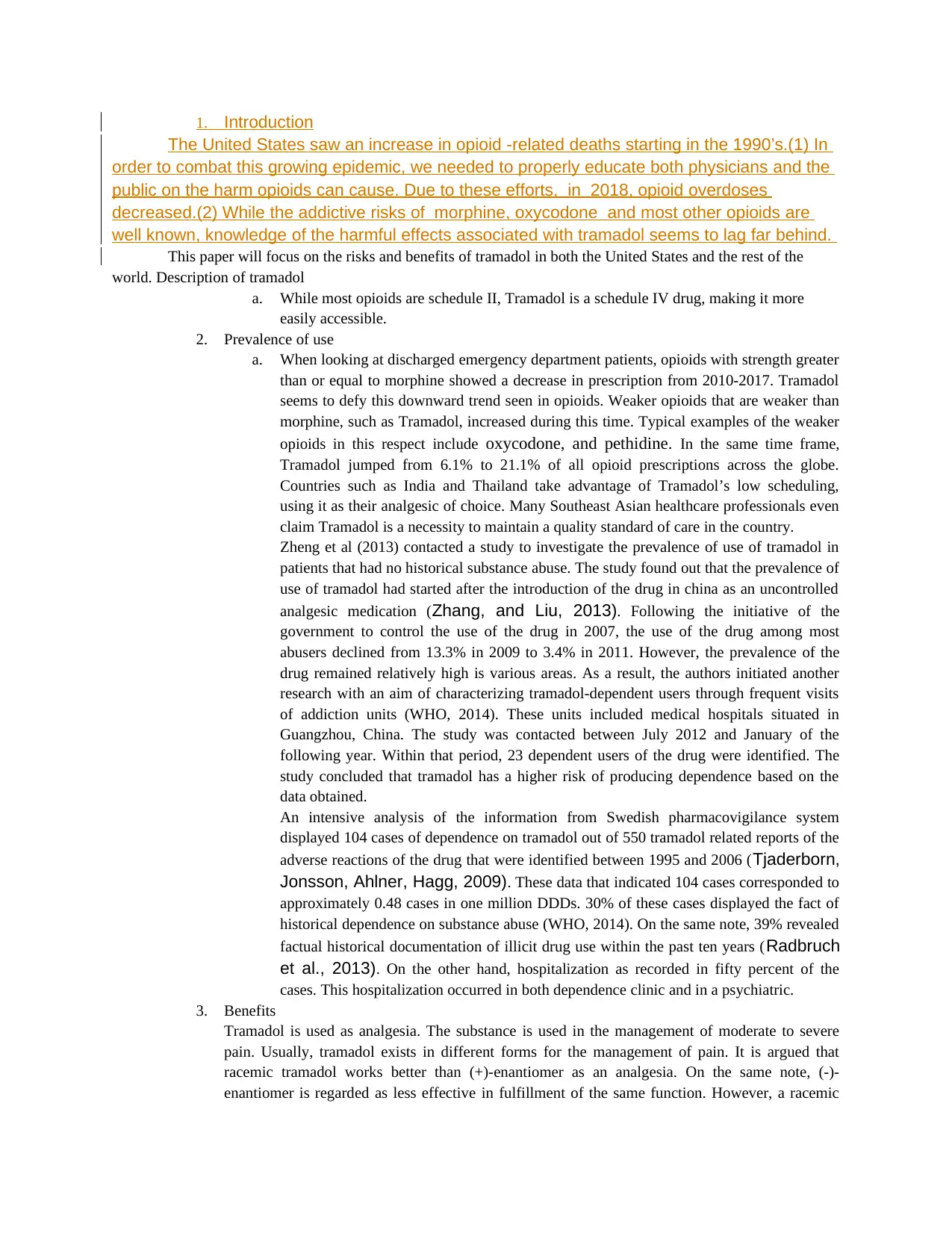
1. Introduction
The United States saw an increase in opioid -related deaths starting in the 1990’s.(1) In
order to combat this growing epidemic, we needed to properly educate both physicians and the
public on the harm opioids can cause. Due to these efforts, in 2018, opioid overdoses
decreased.(2) While the addictive risks of morphine, oxycodone and most other opioids are
well known, knowledge of the harmful effects associated with tramadol seems to lag far behind.
This paper will focus on the risks and benefits of tramadol in both the United States and the rest of the
world. Description of tramadol
a. While most opioids are schedule II, Tramadol is a schedule IV drug, making it more
easily accessible.
2. Prevalence of use
a. When looking at discharged emergency department patients, opioids with strength greater
than or equal to morphine showed a decrease in prescription from 2010-2017. Tramadol
seems to defy this downward trend seen in opioids. Weaker opioids that are weaker than
morphine, such as Tramadol, increased during this time. Typical examples of the weaker
opioids in this respect include oxycodone, and pethidine. In the same time frame,
Tramadol jumped from 6.1% to 21.1% of all opioid prescriptions across the globe.
Countries such as India and Thailand take advantage of Tramadol’s low scheduling,
using it as their analgesic of choice. Many Southeast Asian healthcare professionals even
claim Tramadol is a necessity to maintain a quality standard of care in the country.
Zheng et al (2013) contacted a study to investigate the prevalence of use of tramadol in
patients that had no historical substance abuse. The study found out that the prevalence of
use of tramadol had started after the introduction of the drug in china as an uncontrolled
analgesic medication (Zhang, and Liu, 2013). Following the initiative of the
government to control the use of the drug in 2007, the use of the drug among most
abusers declined from 13.3% in 2009 to 3.4% in 2011. However, the prevalence of the
drug remained relatively high is various areas. As a result, the authors initiated another
research with an aim of characterizing tramadol-dependent users through frequent visits
of addiction units (WHO, 2014). These units included medical hospitals situated in
Guangzhou, China. The study was contacted between July 2012 and January of the
following year. Within that period, 23 dependent users of the drug were identified. The
study concluded that tramadol has a higher risk of producing dependence based on the
data obtained.
An intensive analysis of the information from Swedish pharmacovigilance system
displayed 104 cases of dependence on tramadol out of 550 tramadol related reports of the
adverse reactions of the drug that were identified between 1995 and 2006 (Tjaderborn,
Jonsson, Ahlner, Hagg, 2009). These data that indicated 104 cases corresponded to
approximately 0.48 cases in one million DDDs. 30% of these cases displayed the fact of
historical dependence on substance abuse (WHO, 2014). On the same note, 39% revealed
factual historical documentation of illicit drug use within the past ten years (Radbruch
et al., 2013). On the other hand, hospitalization as recorded in fifty percent of the
cases. This hospitalization occurred in both dependence clinic and in a psychiatric.
3. Benefits
Tramadol is used as analgesia. The substance is used in the management of moderate to severe
pain. Usually, tramadol exists in different forms for the management of pain. It is argued that
racemic tramadol works better than (+)-enantiomer as an analgesia. On the same note, (-)-
enantiomer is regarded as less effective in fulfillment of the same function. However, a racemic
The United States saw an increase in opioid -related deaths starting in the 1990’s.(1) In
order to combat this growing epidemic, we needed to properly educate both physicians and the
public on the harm opioids can cause. Due to these efforts, in 2018, opioid overdoses
decreased.(2) While the addictive risks of morphine, oxycodone and most other opioids are
well known, knowledge of the harmful effects associated with tramadol seems to lag far behind.
This paper will focus on the risks and benefits of tramadol in both the United States and the rest of the
world. Description of tramadol
a. While most opioids are schedule II, Tramadol is a schedule IV drug, making it more
easily accessible.
2. Prevalence of use
a. When looking at discharged emergency department patients, opioids with strength greater
than or equal to morphine showed a decrease in prescription from 2010-2017. Tramadol
seems to defy this downward trend seen in opioids. Weaker opioids that are weaker than
morphine, such as Tramadol, increased during this time. Typical examples of the weaker
opioids in this respect include oxycodone, and pethidine. In the same time frame,
Tramadol jumped from 6.1% to 21.1% of all opioid prescriptions across the globe.
Countries such as India and Thailand take advantage of Tramadol’s low scheduling,
using it as their analgesic of choice. Many Southeast Asian healthcare professionals even
claim Tramadol is a necessity to maintain a quality standard of care in the country.
Zheng et al (2013) contacted a study to investigate the prevalence of use of tramadol in
patients that had no historical substance abuse. The study found out that the prevalence of
use of tramadol had started after the introduction of the drug in china as an uncontrolled
analgesic medication (Zhang, and Liu, 2013). Following the initiative of the
government to control the use of the drug in 2007, the use of the drug among most
abusers declined from 13.3% in 2009 to 3.4% in 2011. However, the prevalence of the
drug remained relatively high is various areas. As a result, the authors initiated another
research with an aim of characterizing tramadol-dependent users through frequent visits
of addiction units (WHO, 2014). These units included medical hospitals situated in
Guangzhou, China. The study was contacted between July 2012 and January of the
following year. Within that period, 23 dependent users of the drug were identified. The
study concluded that tramadol has a higher risk of producing dependence based on the
data obtained.
An intensive analysis of the information from Swedish pharmacovigilance system
displayed 104 cases of dependence on tramadol out of 550 tramadol related reports of the
adverse reactions of the drug that were identified between 1995 and 2006 (Tjaderborn,
Jonsson, Ahlner, Hagg, 2009). These data that indicated 104 cases corresponded to
approximately 0.48 cases in one million DDDs. 30% of these cases displayed the fact of
historical dependence on substance abuse (WHO, 2014). On the same note, 39% revealed
factual historical documentation of illicit drug use within the past ten years (Radbruch
et al., 2013). On the other hand, hospitalization as recorded in fifty percent of the
cases. This hospitalization occurred in both dependence clinic and in a psychiatric.
3. Benefits
Tramadol is used as analgesia. The substance is used in the management of moderate to severe
pain. Usually, tramadol exists in different forms for the management of pain. It is argued that
racemic tramadol works better than (+)-enantiomer as an analgesia. On the same note, (-)-
enantiomer is regarded as less effective in fulfillment of the same function. However, a racemic
Paraphrase This Document
Need a fresh take? Get an instant paraphrase of this document with our AI Paraphraser
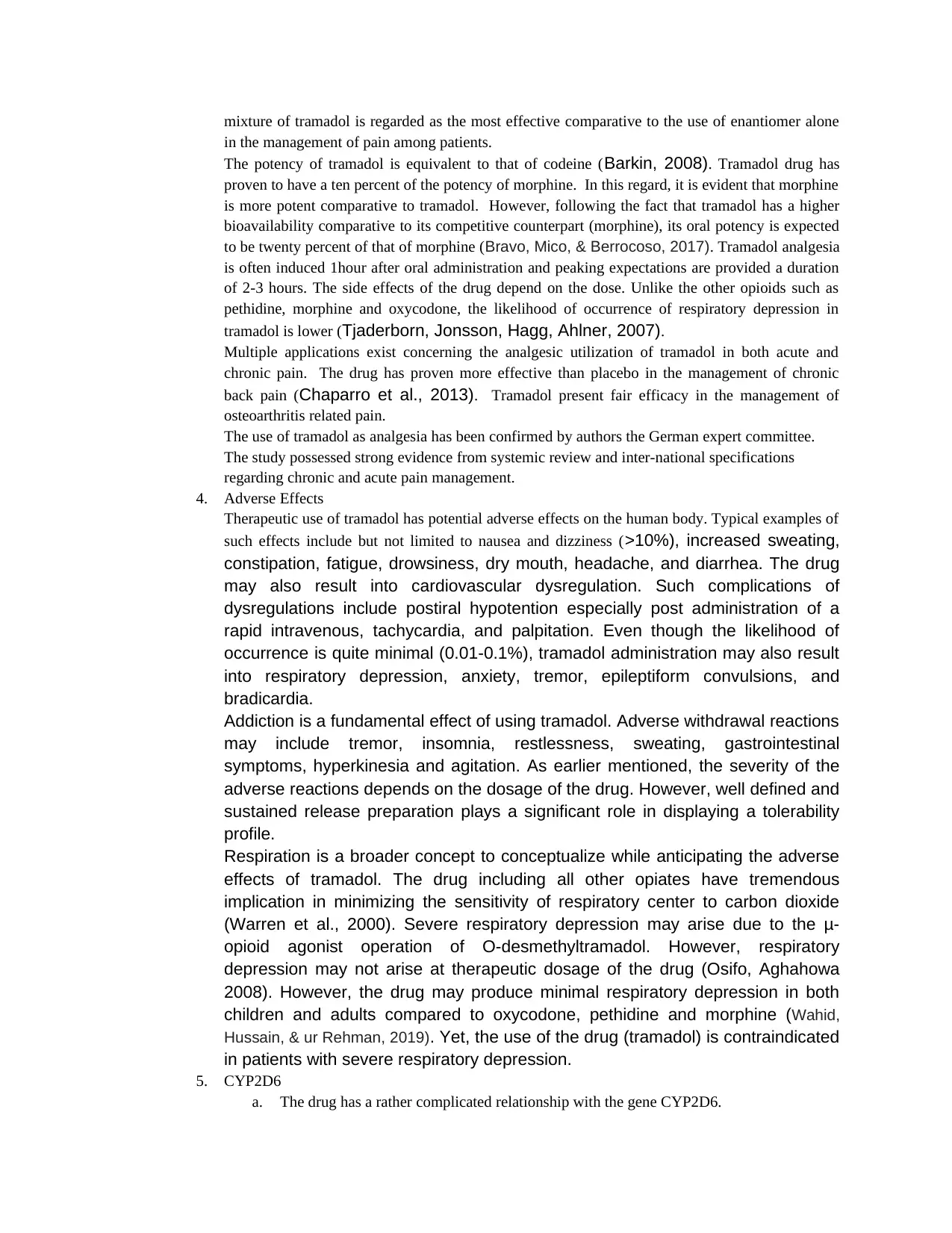
mixture of tramadol is regarded as the most effective comparative to the use of enantiomer alone
in the management of pain among patients.
The potency of tramadol is equivalent to that of codeine (Barkin, 2008). Tramadol drug has
proven to have a ten percent of the potency of morphine. In this regard, it is evident that morphine
is more potent comparative to tramadol. However, following the fact that tramadol has a higher
bioavailability comparative to its competitive counterpart (morphine), its oral potency is expected
to be twenty percent of that of morphine (Bravo, Mico, & Berrocoso, 2017). Tramadol analgesia
is often induced 1hour after oral administration and peaking expectations are provided a duration
of 2-3 hours. The side effects of the drug depend on the dose. Unlike the other opioids such as
pethidine, morphine and oxycodone, the likelihood of occurrence of respiratory depression in
tramadol is lower (Tjaderborn, Jonsson, Hagg, Ahlner, 2007).
Multiple applications exist concerning the analgesic utilization of tramadol in both acute and
chronic pain. The drug has proven more effective than placebo in the management of chronic
back pain (Chaparro et al., 2013). Tramadol present fair efficacy in the management of
osteoarthritis related pain.
The use of tramadol as analgesia has been confirmed by authors the German expert committee.
The study possessed strong evidence from systemic review and inter-national specifications
regarding chronic and acute pain management.
4. Adverse Effects
Therapeutic use of tramadol has potential adverse effects on the human body. Typical examples of
such effects include but not limited to nausea and dizziness (>10%), increased sweating,
constipation, fatigue, drowsiness, dry mouth, headache, and diarrhea. The drug
may also result into cardiovascular dysregulation. Such complications of
dysregulations include postiral hypotention especially post administration of a
rapid intravenous, tachycardia, and palpitation. Even though the likelihood of
occurrence is quite minimal (0.01-0.1%), tramadol administration may also result
into respiratory depression, anxiety, tremor, epileptiform convulsions, and
bradicardia.
Addiction is a fundamental effect of using tramadol. Adverse withdrawal reactions
may include tremor, insomnia, restlessness, sweating, gastrointestinal
symptoms, hyperkinesia and agitation. As earlier mentioned, the severity of the
adverse reactions depends on the dosage of the drug. However, well defined and
sustained release preparation plays a significant role in displaying a tolerability
profile.
Respiration is a broader concept to conceptualize while anticipating the adverse
effects of tramadol. The drug including all other opiates have tremendous
implication in minimizing the sensitivity of respiratory center to carbon dioxide
(Warren et al., 2000). Severe respiratory depression may arise due to the μ-
opioid agonist operation of O-desmethyltramadol. However, respiratory
depression may not arise at therapeutic dosage of the drug (Osifo, Aghahowa
2008). However, the drug may produce minimal respiratory depression in both
children and adults compared to oxycodone, pethidine and morphine (Wahid,
Hussain, & ur Rehman, 2019). Yet, the use of the drug (tramadol) is contraindicated
in patients with severe respiratory depression.
5. CYP2D6
a. The drug has a rather complicated relationship with the gene CYP2D6.
in the management of pain among patients.
The potency of tramadol is equivalent to that of codeine (Barkin, 2008). Tramadol drug has
proven to have a ten percent of the potency of morphine. In this regard, it is evident that morphine
is more potent comparative to tramadol. However, following the fact that tramadol has a higher
bioavailability comparative to its competitive counterpart (morphine), its oral potency is expected
to be twenty percent of that of morphine (Bravo, Mico, & Berrocoso, 2017). Tramadol analgesia
is often induced 1hour after oral administration and peaking expectations are provided a duration
of 2-3 hours. The side effects of the drug depend on the dose. Unlike the other opioids such as
pethidine, morphine and oxycodone, the likelihood of occurrence of respiratory depression in
tramadol is lower (Tjaderborn, Jonsson, Hagg, Ahlner, 2007).
Multiple applications exist concerning the analgesic utilization of tramadol in both acute and
chronic pain. The drug has proven more effective than placebo in the management of chronic
back pain (Chaparro et al., 2013). Tramadol present fair efficacy in the management of
osteoarthritis related pain.
The use of tramadol as analgesia has been confirmed by authors the German expert committee.
The study possessed strong evidence from systemic review and inter-national specifications
regarding chronic and acute pain management.
4. Adverse Effects
Therapeutic use of tramadol has potential adverse effects on the human body. Typical examples of
such effects include but not limited to nausea and dizziness (>10%), increased sweating,
constipation, fatigue, drowsiness, dry mouth, headache, and diarrhea. The drug
may also result into cardiovascular dysregulation. Such complications of
dysregulations include postiral hypotention especially post administration of a
rapid intravenous, tachycardia, and palpitation. Even though the likelihood of
occurrence is quite minimal (0.01-0.1%), tramadol administration may also result
into respiratory depression, anxiety, tremor, epileptiform convulsions, and
bradicardia.
Addiction is a fundamental effect of using tramadol. Adverse withdrawal reactions
may include tremor, insomnia, restlessness, sweating, gastrointestinal
symptoms, hyperkinesia and agitation. As earlier mentioned, the severity of the
adverse reactions depends on the dosage of the drug. However, well defined and
sustained release preparation plays a significant role in displaying a tolerability
profile.
Respiration is a broader concept to conceptualize while anticipating the adverse
effects of tramadol. The drug including all other opiates have tremendous
implication in minimizing the sensitivity of respiratory center to carbon dioxide
(Warren et al., 2000). Severe respiratory depression may arise due to the μ-
opioid agonist operation of O-desmethyltramadol. However, respiratory
depression may not arise at therapeutic dosage of the drug (Osifo, Aghahowa
2008). However, the drug may produce minimal respiratory depression in both
children and adults compared to oxycodone, pethidine and morphine (Wahid,
Hussain, & ur Rehman, 2019). Yet, the use of the drug (tramadol) is contraindicated
in patients with severe respiratory depression.
5. CYP2D6
a. The drug has a rather complicated relationship with the gene CYP2D6.
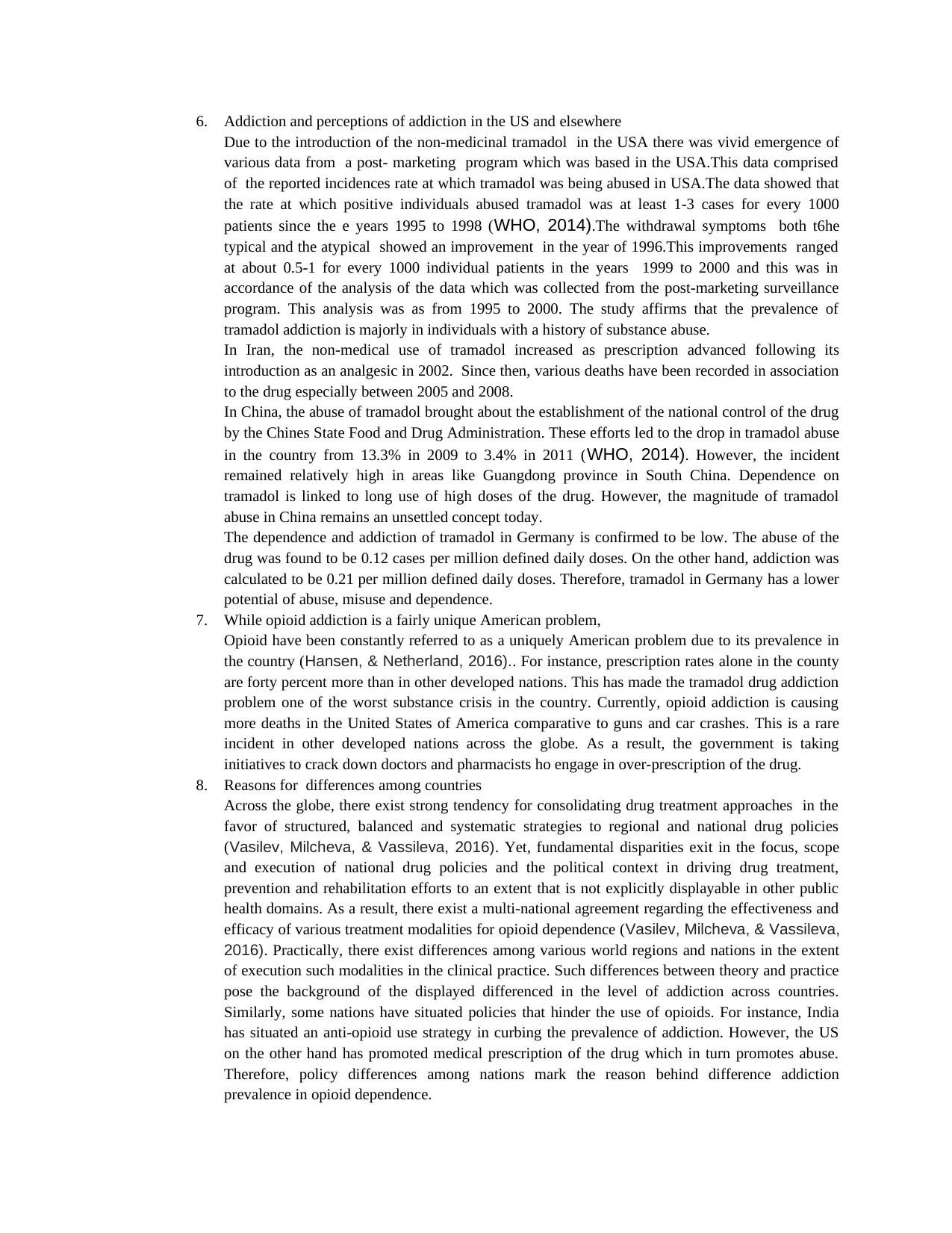
6. Addiction and perceptions of addiction in the US and elsewhere
Due to the introduction of the non-medicinal tramadol in the USA there was vivid emergence of
various data from a post- marketing program which was based in the USA.This data comprised
of the reported incidences rate at which tramadol was being abused in USA.The data showed that
the rate at which positive individuals abused tramadol was at least 1-3 cases for every 1000
patients since the e years 1995 to 1998 (WHO, 2014).The withdrawal symptoms both t6he
typical and the atypical showed an improvement in the year of 1996.This improvements ranged
at about 0.5-1 for every 1000 individual patients in the years 1999 to 2000 and this was in
accordance of the analysis of the data which was collected from the post-marketing surveillance
program. This analysis was as from 1995 to 2000. The study affirms that the prevalence of
tramadol addiction is majorly in individuals with a history of substance abuse.
In Iran, the non-medical use of tramadol increased as prescription advanced following its
introduction as an analgesic in 2002. Since then, various deaths have been recorded in association
to the drug especially between 2005 and 2008.
In China, the abuse of tramadol brought about the establishment of the national control of the drug
by the Chines State Food and Drug Administration. These efforts led to the drop in tramadol abuse
in the country from 13.3% in 2009 to 3.4% in 2011 (WHO, 2014). However, the incident
remained relatively high in areas like Guangdong province in South China. Dependence on
tramadol is linked to long use of high doses of the drug. However, the magnitude of tramadol
abuse in China remains an unsettled concept today.
The dependence and addiction of tramadol in Germany is confirmed to be low. The abuse of the
drug was found to be 0.12 cases per million defined daily doses. On the other hand, addiction was
calculated to be 0.21 per million defined daily doses. Therefore, tramadol in Germany has a lower
potential of abuse, misuse and dependence.
7. While opioid addiction is a fairly unique American problem,
Opioid have been constantly referred to as a uniquely American problem due to its prevalence in
the country (Hansen, & Netherland, 2016).. For instance, prescription rates alone in the county
are forty percent more than in other developed nations. This has made the tramadol drug addiction
problem one of the worst substance crisis in the country. Currently, opioid addiction is causing
more deaths in the United States of America comparative to guns and car crashes. This is a rare
incident in other developed nations across the globe. As a result, the government is taking
initiatives to crack down doctors and pharmacists ho engage in over-prescription of the drug.
8. Reasons for differences among countries
Across the globe, there exist strong tendency for consolidating drug treatment approaches in the
favor of structured, balanced and systematic strategies to regional and national drug policies
(Vasilev, Milcheva, & Vassileva, 2016). Yet, fundamental disparities exit in the focus, scope
and execution of national drug policies and the political context in driving drug treatment,
prevention and rehabilitation efforts to an extent that is not explicitly displayable in other public
health domains. As a result, there exist a multi-national agreement regarding the effectiveness and
efficacy of various treatment modalities for opioid dependence (Vasilev, Milcheva, & Vassileva,
2016). Practically, there exist differences among various world regions and nations in the extent
of execution such modalities in the clinical practice. Such differences between theory and practice
pose the background of the displayed differenced in the level of addiction across countries.
Similarly, some nations have situated policies that hinder the use of opioids. For instance, India
has situated an anti-opioid use strategy in curbing the prevalence of addiction. However, the US
on the other hand has promoted medical prescription of the drug which in turn promotes abuse.
Therefore, policy differences among nations mark the reason behind difference addiction
prevalence in opioid dependence.
Due to the introduction of the non-medicinal tramadol in the USA there was vivid emergence of
various data from a post- marketing program which was based in the USA.This data comprised
of the reported incidences rate at which tramadol was being abused in USA.The data showed that
the rate at which positive individuals abused tramadol was at least 1-3 cases for every 1000
patients since the e years 1995 to 1998 (WHO, 2014).The withdrawal symptoms both t6he
typical and the atypical showed an improvement in the year of 1996.This improvements ranged
at about 0.5-1 for every 1000 individual patients in the years 1999 to 2000 and this was in
accordance of the analysis of the data which was collected from the post-marketing surveillance
program. This analysis was as from 1995 to 2000. The study affirms that the prevalence of
tramadol addiction is majorly in individuals with a history of substance abuse.
In Iran, the non-medical use of tramadol increased as prescription advanced following its
introduction as an analgesic in 2002. Since then, various deaths have been recorded in association
to the drug especially between 2005 and 2008.
In China, the abuse of tramadol brought about the establishment of the national control of the drug
by the Chines State Food and Drug Administration. These efforts led to the drop in tramadol abuse
in the country from 13.3% in 2009 to 3.4% in 2011 (WHO, 2014). However, the incident
remained relatively high in areas like Guangdong province in South China. Dependence on
tramadol is linked to long use of high doses of the drug. However, the magnitude of tramadol
abuse in China remains an unsettled concept today.
The dependence and addiction of tramadol in Germany is confirmed to be low. The abuse of the
drug was found to be 0.12 cases per million defined daily doses. On the other hand, addiction was
calculated to be 0.21 per million defined daily doses. Therefore, tramadol in Germany has a lower
potential of abuse, misuse and dependence.
7. While opioid addiction is a fairly unique American problem,
Opioid have been constantly referred to as a uniquely American problem due to its prevalence in
the country (Hansen, & Netherland, 2016).. For instance, prescription rates alone in the county
are forty percent more than in other developed nations. This has made the tramadol drug addiction
problem one of the worst substance crisis in the country. Currently, opioid addiction is causing
more deaths in the United States of America comparative to guns and car crashes. This is a rare
incident in other developed nations across the globe. As a result, the government is taking
initiatives to crack down doctors and pharmacists ho engage in over-prescription of the drug.
8. Reasons for differences among countries
Across the globe, there exist strong tendency for consolidating drug treatment approaches in the
favor of structured, balanced and systematic strategies to regional and national drug policies
(Vasilev, Milcheva, & Vassileva, 2016). Yet, fundamental disparities exit in the focus, scope
and execution of national drug policies and the political context in driving drug treatment,
prevention and rehabilitation efforts to an extent that is not explicitly displayable in other public
health domains. As a result, there exist a multi-national agreement regarding the effectiveness and
efficacy of various treatment modalities for opioid dependence (Vasilev, Milcheva, & Vassileva,
2016). Practically, there exist differences among various world regions and nations in the extent
of execution such modalities in the clinical practice. Such differences between theory and practice
pose the background of the displayed differenced in the level of addiction across countries.
Similarly, some nations have situated policies that hinder the use of opioids. For instance, India
has situated an anti-opioid use strategy in curbing the prevalence of addiction. However, the US
on the other hand has promoted medical prescription of the drug which in turn promotes abuse.
Therefore, policy differences among nations mark the reason behind difference addiction
prevalence in opioid dependence.
⊘ This is a preview!⊘
Do you want full access?
Subscribe today to unlock all pages.

Trusted by 1+ million students worldwide
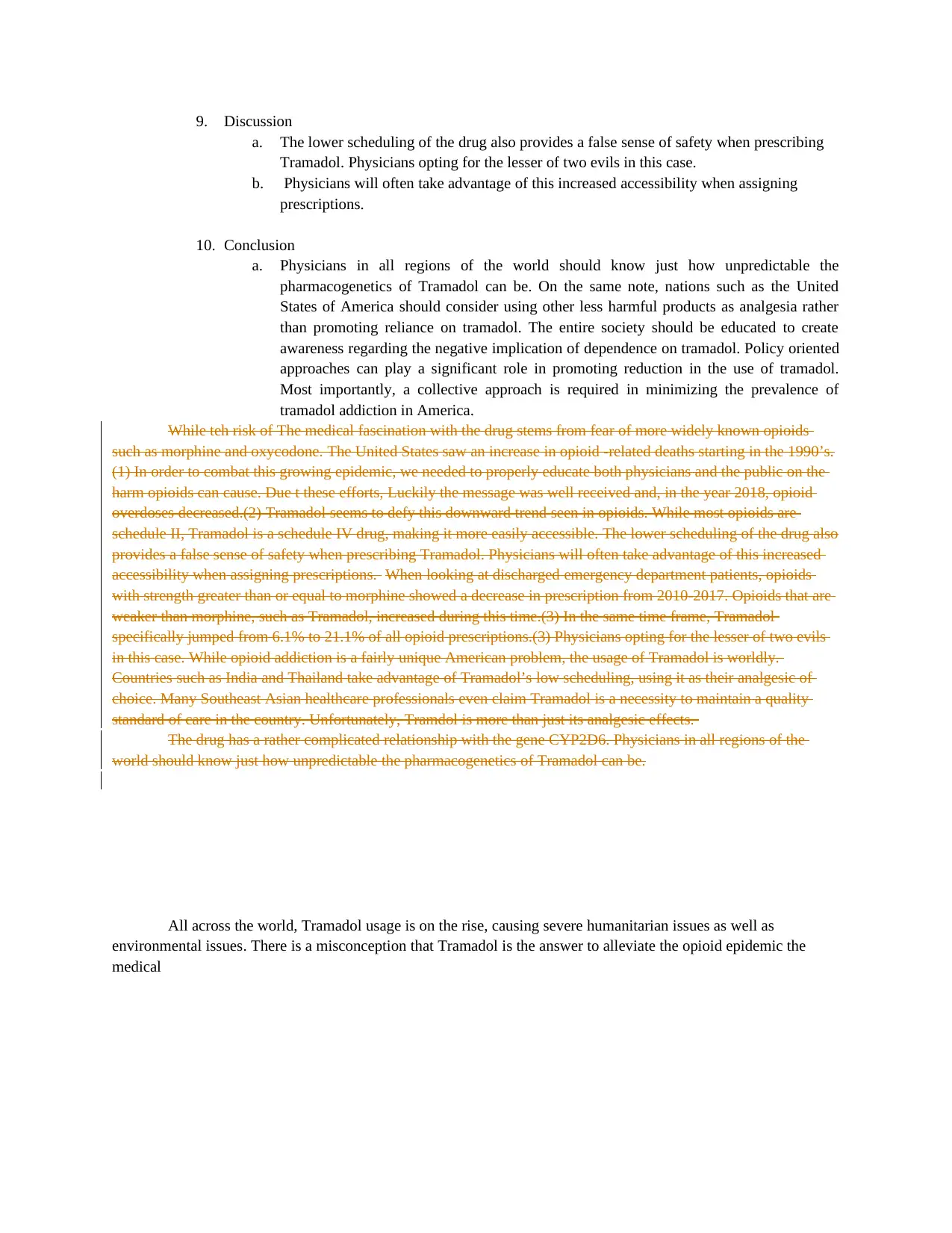
9. Discussion
a. The lower scheduling of the drug also provides a false sense of safety when prescribing
Tramadol. Physicians opting for the lesser of two evils in this case.
b. Physicians will often take advantage of this increased accessibility when assigning
prescriptions.
10. Conclusion
a. Physicians in all regions of the world should know just how unpredictable the
pharmacogenetics of Tramadol can be. On the same note, nations such as the United
States of America should consider using other less harmful products as analgesia rather
than promoting reliance on tramadol. The entire society should be educated to create
awareness regarding the negative implication of dependence on tramadol. Policy oriented
approaches can play a significant role in promoting reduction in the use of tramadol.
Most importantly, a collective approach is required in minimizing the prevalence of
tramadol addiction in America.
While teh risk of The medical fascination with the drug stems from fear of more widely known opioids
such as morphine and oxycodone. The United States saw an increase in opioid -related deaths starting in the 1990’s.
(1) In order to combat this growing epidemic, we needed to properly educate both physicians and the public on the
harm opioids can cause. Due t these efforts, Luckily the message was well received and, in the year 2018, opioid
overdoses decreased.(2) Tramadol seems to defy this downward trend seen in opioids. While most opioids are
schedule II, Tramadol is a schedule IV drug, making it more easily accessible. The lower scheduling of the drug also
provides a false sense of safety when prescribing Tramadol. Physicians will often take advantage of this increased
accessibility when assigning prescriptions. When looking at discharged emergency department patients, opioids
with strength greater than or equal to morphine showed a decrease in prescription from 2010-2017. Opioids that are
weaker than morphine, such as Tramadol, increased during this time.(3) In the same time frame, Tramadol
specifically jumped from 6.1% to 21.1% of all opioid prescriptions.(3) Physicians opting for the lesser of two evils
in this case. While opioid addiction is a fairly unique American problem, the usage of Tramadol is worldly.
Countries such as India and Thailand take advantage of Tramadol’s low scheduling, using it as their analgesic of
choice. Many Southeast Asian healthcare professionals even claim Tramadol is a necessity to maintain a quality
standard of care in the country. Unfortunately, Tramdol is more than just its analgesic effects.
The drug has a rather complicated relationship with the gene CYP2D6. Physicians in all regions of the
world should know just how unpredictable the pharmacogenetics of Tramadol can be.
All across the world, Tramadol usage is on the rise, causing severe humanitarian issues as well as
environmental issues. There is a misconception that Tramadol is the answer to alleviate the opioid epidemic the
medical
a. The lower scheduling of the drug also provides a false sense of safety when prescribing
Tramadol. Physicians opting for the lesser of two evils in this case.
b. Physicians will often take advantage of this increased accessibility when assigning
prescriptions.
10. Conclusion
a. Physicians in all regions of the world should know just how unpredictable the
pharmacogenetics of Tramadol can be. On the same note, nations such as the United
States of America should consider using other less harmful products as analgesia rather
than promoting reliance on tramadol. The entire society should be educated to create
awareness regarding the negative implication of dependence on tramadol. Policy oriented
approaches can play a significant role in promoting reduction in the use of tramadol.
Most importantly, a collective approach is required in minimizing the prevalence of
tramadol addiction in America.
While teh risk of The medical fascination with the drug stems from fear of more widely known opioids
such as morphine and oxycodone. The United States saw an increase in opioid -related deaths starting in the 1990’s.
(1) In order to combat this growing epidemic, we needed to properly educate both physicians and the public on the
harm opioids can cause. Due t these efforts, Luckily the message was well received and, in the year 2018, opioid
overdoses decreased.(2) Tramadol seems to defy this downward trend seen in opioids. While most opioids are
schedule II, Tramadol is a schedule IV drug, making it more easily accessible. The lower scheduling of the drug also
provides a false sense of safety when prescribing Tramadol. Physicians will often take advantage of this increased
accessibility when assigning prescriptions. When looking at discharged emergency department patients, opioids
with strength greater than or equal to morphine showed a decrease in prescription from 2010-2017. Opioids that are
weaker than morphine, such as Tramadol, increased during this time.(3) In the same time frame, Tramadol
specifically jumped from 6.1% to 21.1% of all opioid prescriptions.(3) Physicians opting for the lesser of two evils
in this case. While opioid addiction is a fairly unique American problem, the usage of Tramadol is worldly.
Countries such as India and Thailand take advantage of Tramadol’s low scheduling, using it as their analgesic of
choice. Many Southeast Asian healthcare professionals even claim Tramadol is a necessity to maintain a quality
standard of care in the country. Unfortunately, Tramdol is more than just its analgesic effects.
The drug has a rather complicated relationship with the gene CYP2D6. Physicians in all regions of the
world should know just how unpredictable the pharmacogenetics of Tramadol can be.
All across the world, Tramadol usage is on the rise, causing severe humanitarian issues as well as
environmental issues. There is a misconception that Tramadol is the answer to alleviate the opioid epidemic the
medical
Paraphrase This Document
Need a fresh take? Get an instant paraphrase of this document with our AI Paraphraser
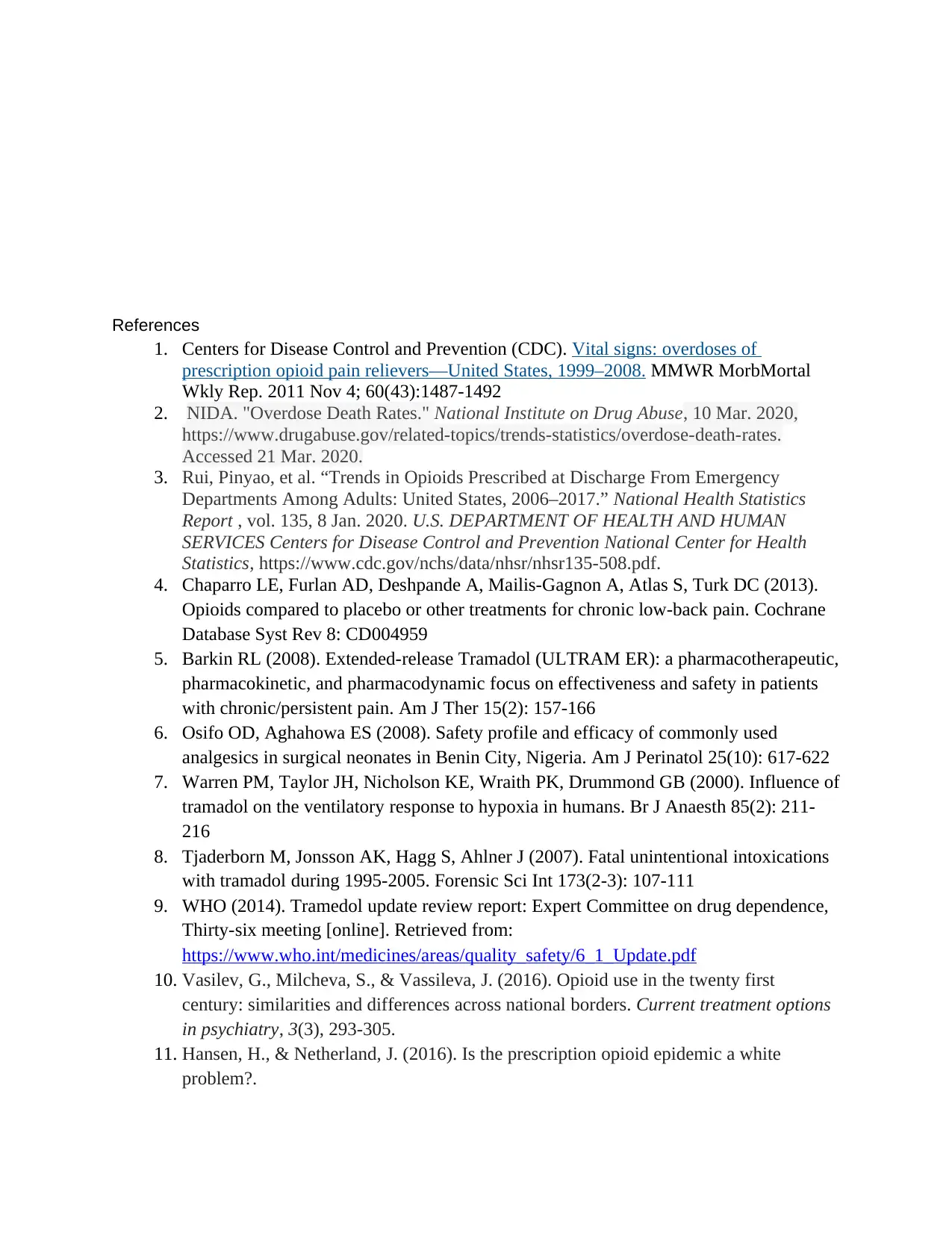
References
1. Centers for Disease Control and Prevention (CDC). Vital signs: overdoses of
prescription opioid pain relievers—United States, 1999–2008. MMWR MorbMortal
Wkly Rep. 2011 Nov 4; 60(43):1487-1492
2. NIDA. "Overdose Death Rates." National Institute on Drug Abuse, 10 Mar. 2020,
https://www.drugabuse.gov/related-topics/trends-statistics/overdose-death-rates.
Accessed 21 Mar. 2020.
3. Rui, Pinyao, et al. “Trends in Opioids Prescribed at Discharge From Emergency
Departments Among Adults: United States, 2006–2017.” National Health Statistics
Report , vol. 135, 8 Jan. 2020. U.S. DEPARTMENT OF HEALTH AND HUMAN
SERVICES Centers for Disease Control and Prevention National Center for Health
Statistics, https://www.cdc.gov/nchs/data/nhsr/nhsr135-508.pdf.
4. Chaparro LE, Furlan AD, Deshpande A, Mailis-Gagnon A, Atlas S, Turk DC (2013).
Opioids compared to placebo or other treatments for chronic low-back pain. Cochrane
Database Syst Rev 8: CD004959
5. Barkin RL (2008). Extended-release Tramadol (ULTRAM ER): a pharmacotherapeutic,
pharmacokinetic, and pharmacodynamic focus on effectiveness and safety in patients
with chronic/persistent pain. Am J Ther 15(2): 157-166
6. Osifo OD, Aghahowa ES (2008). Safety profile and efficacy of commonly used
analgesics in surgical neonates in Benin City, Nigeria. Am J Perinatol 25(10): 617-622
7. Warren PM, Taylor JH, Nicholson KE, Wraith PK, Drummond GB (2000). Influence of
tramadol on the ventilatory response to hypoxia in humans. Br J Anaesth 85(2): 211-
216
8. Tjaderborn M, Jonsson AK, Hagg S, Ahlner J (2007). Fatal unintentional intoxications
with tramadol during 1995-2005. Forensic Sci Int 173(2-3): 107-111
9. WHO (2014). Tramedol update review report: Expert Committee on drug dependence,
Thirty-six meeting [online]. Retrieved from:
https://www.who.int/medicines/areas/quality_safety/6_1_Update.pdf
10. Vasilev, G., Milcheva, S., & Vassileva, J. (2016). Opioid use in the twenty first
century: similarities and differences across national borders. Current treatment options
in psychiatry, 3(3), 293-305.
11. Hansen, H., & Netherland, J. (2016). Is the prescription opioid epidemic a white
problem?.
1. Centers for Disease Control and Prevention (CDC). Vital signs: overdoses of
prescription opioid pain relievers—United States, 1999–2008. MMWR MorbMortal
Wkly Rep. 2011 Nov 4; 60(43):1487-1492
2. NIDA. "Overdose Death Rates." National Institute on Drug Abuse, 10 Mar. 2020,
https://www.drugabuse.gov/related-topics/trends-statistics/overdose-death-rates.
Accessed 21 Mar. 2020.
3. Rui, Pinyao, et al. “Trends in Opioids Prescribed at Discharge From Emergency
Departments Among Adults: United States, 2006–2017.” National Health Statistics
Report , vol. 135, 8 Jan. 2020. U.S. DEPARTMENT OF HEALTH AND HUMAN
SERVICES Centers for Disease Control and Prevention National Center for Health
Statistics, https://www.cdc.gov/nchs/data/nhsr/nhsr135-508.pdf.
4. Chaparro LE, Furlan AD, Deshpande A, Mailis-Gagnon A, Atlas S, Turk DC (2013).
Opioids compared to placebo or other treatments for chronic low-back pain. Cochrane
Database Syst Rev 8: CD004959
5. Barkin RL (2008). Extended-release Tramadol (ULTRAM ER): a pharmacotherapeutic,
pharmacokinetic, and pharmacodynamic focus on effectiveness and safety in patients
with chronic/persistent pain. Am J Ther 15(2): 157-166
6. Osifo OD, Aghahowa ES (2008). Safety profile and efficacy of commonly used
analgesics in surgical neonates in Benin City, Nigeria. Am J Perinatol 25(10): 617-622
7. Warren PM, Taylor JH, Nicholson KE, Wraith PK, Drummond GB (2000). Influence of
tramadol on the ventilatory response to hypoxia in humans. Br J Anaesth 85(2): 211-
216
8. Tjaderborn M, Jonsson AK, Hagg S, Ahlner J (2007). Fatal unintentional intoxications
with tramadol during 1995-2005. Forensic Sci Int 173(2-3): 107-111
9. WHO (2014). Tramedol update review report: Expert Committee on drug dependence,
Thirty-six meeting [online]. Retrieved from:
https://www.who.int/medicines/areas/quality_safety/6_1_Update.pdf
10. Vasilev, G., Milcheva, S., & Vassileva, J. (2016). Opioid use in the twenty first
century: similarities and differences across national borders. Current treatment options
in psychiatry, 3(3), 293-305.
11. Hansen, H., & Netherland, J. (2016). Is the prescription opioid epidemic a white
problem?.
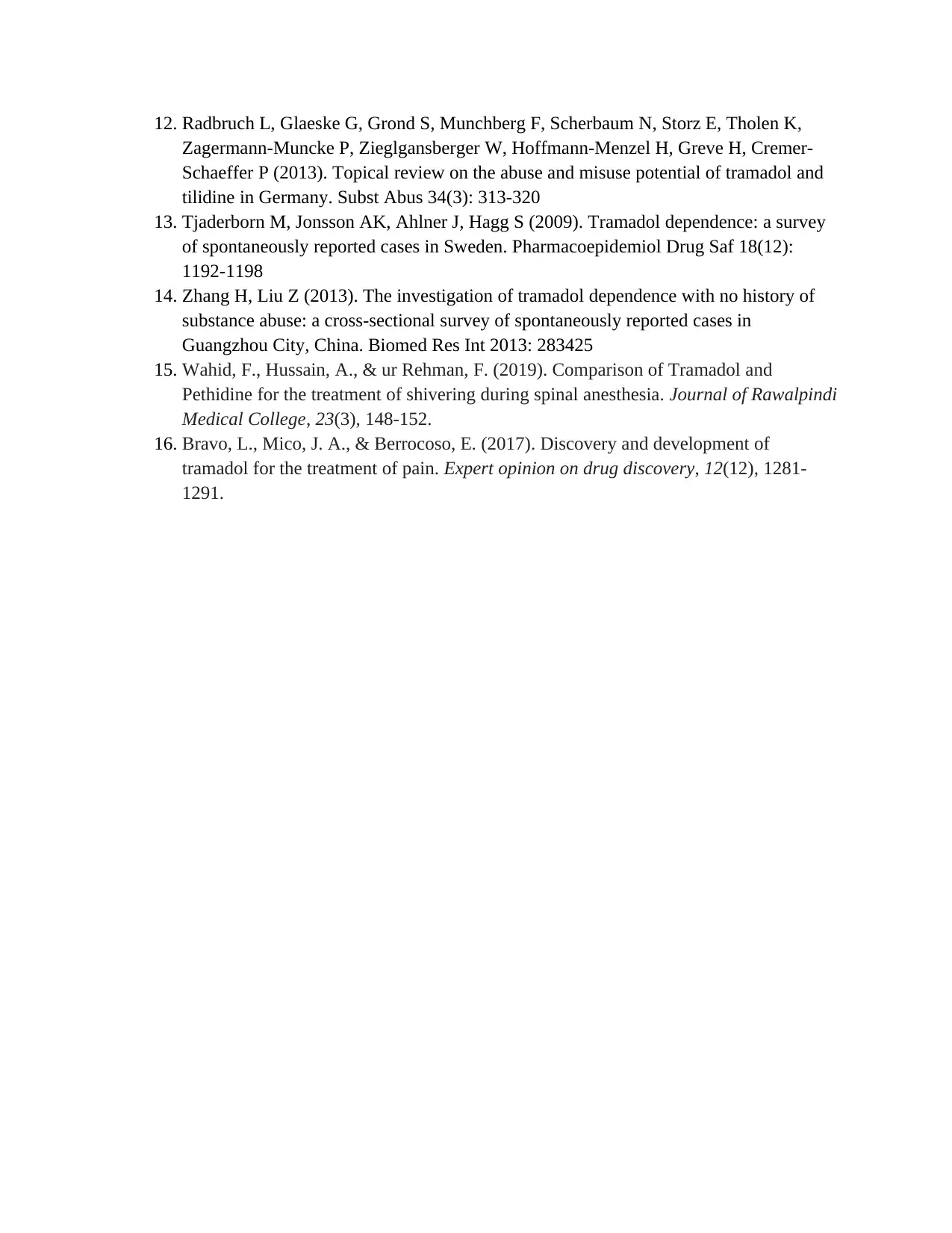
12. Radbruch L, Glaeske G, Grond S, Munchberg F, Scherbaum N, Storz E, Tholen K,
Zagermann-Muncke P, Zieglgansberger W, Hoffmann-Menzel H, Greve H, Cremer-
Schaeffer P (2013). Topical review on the abuse and misuse potential of tramadol and
tilidine in Germany. Subst Abus 34(3): 313-320
13. Tjaderborn M, Jonsson AK, Ahlner J, Hagg S (2009). Tramadol dependence: a survey
of spontaneously reported cases in Sweden. Pharmacoepidemiol Drug Saf 18(12):
1192-1198
14. Zhang H, Liu Z (2013). The investigation of tramadol dependence with no history of
substance abuse: a cross-sectional survey of spontaneously reported cases in
Guangzhou City, China. Biomed Res Int 2013: 283425
15. Wahid, F., Hussain, A., & ur Rehman, F. (2019). Comparison of Tramadol and
Pethidine for the treatment of shivering during spinal anesthesia. Journal of Rawalpindi
Medical College, 23(3), 148-152.
16. Bravo, L., Mico, J. A., & Berrocoso, E. (2017). Discovery and development of
tramadol for the treatment of pain. Expert opinion on drug discovery, 12(12), 1281-
1291.
Zagermann-Muncke P, Zieglgansberger W, Hoffmann-Menzel H, Greve H, Cremer-
Schaeffer P (2013). Topical review on the abuse and misuse potential of tramadol and
tilidine in Germany. Subst Abus 34(3): 313-320
13. Tjaderborn M, Jonsson AK, Ahlner J, Hagg S (2009). Tramadol dependence: a survey
of spontaneously reported cases in Sweden. Pharmacoepidemiol Drug Saf 18(12):
1192-1198
14. Zhang H, Liu Z (2013). The investigation of tramadol dependence with no history of
substance abuse: a cross-sectional survey of spontaneously reported cases in
Guangzhou City, China. Biomed Res Int 2013: 283425
15. Wahid, F., Hussain, A., & ur Rehman, F. (2019). Comparison of Tramadol and
Pethidine for the treatment of shivering during spinal anesthesia. Journal of Rawalpindi
Medical College, 23(3), 148-152.
16. Bravo, L., Mico, J. A., & Berrocoso, E. (2017). Discovery and development of
tramadol for the treatment of pain. Expert opinion on drug discovery, 12(12), 1281-
1291.
⊘ This is a preview!⊘
Do you want full access?
Subscribe today to unlock all pages.

Trusted by 1+ million students worldwide
1 out of 6
Your All-in-One AI-Powered Toolkit for Academic Success.
+13062052269
info@desklib.com
Available 24*7 on WhatsApp / Email
![[object Object]](/_next/static/media/star-bottom.7253800d.svg)
Unlock your academic potential
Copyright © 2020–2025 A2Z Services. All Rights Reserved. Developed and managed by ZUCOL.


